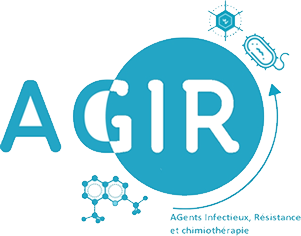CT Imaging Assessment of Response to Treatment in Allergic Bronchopulmonary Aspergillosis in Adults With Bronchial Asthma
Résumé
Background: One of the major challenges in managing allergic bronchopulmonary aspergillosis (ABPA) remains consistent and reproducible assessment of response to treatment.Research questionWhat are the most relevant changes in computed tomography (CT-scan) parameters over time for assessing response to treatment?
Study Design and Methods: In this ancillary study of a randomized clinical trial (NEBULAMB), asthmatic patients with available CT-scan and without exacerbation during a 4-month ABPA exacerbation treatment period (corticosteroids and itraconazole) were included. Changed CT-scan parameters were assessed by systematic analyses of CT-scan findings at initiation (M0) and end of treatment (M4). CT-scans were assessed by two radiologists blinded to the clinical data. Radiological parameters were determined by selecting those showing significant changes over time. Improvement of at least one, without worsening of the others, defined the radiological response. Agreement between radiological changes, clinical and immunologic responses was likewise investigated.
Results: Among the 139 originally randomized patients, 132 were included. We identified 5 CT-scan parameters showing significant changes at M4: mucoid impaction extent, mucoid impaction density, centrilobular micronodules, consolidation/ground-glass opacities and bronchial wall thickening (P<0.05). These changes were only weakly associated with one another, except for mucoid impaction extent and density. No agreement was observed between clinical or immunologic and radiological responses, assessed as an overall response, or considering each of the parameters (Cohen’s κ, -0.01 to 0.24).
Interpretation: Changes in extent and density of mucoid impactions, centrilobular micronodules, consolidation/ground-glass opacities and thickening of the bronchial walls were found to be the most relevant CT-scan parameters to assess radiological response to treatment. A clinical, immunologic and radiological multidimensional approach should be adopted to assess outcomes, probably with a composite definition of response to treatment.
Study Design and Methods: In this ancillary study of a randomized clinical trial (NEBULAMB), asthmatic patients with available CT-scan and without exacerbation during a 4-month ABPA exacerbation treatment period (corticosteroids and itraconazole) were included. Changed CT-scan parameters were assessed by systematic analyses of CT-scan findings at initiation (M0) and end of treatment (M4). CT-scans were assessed by two radiologists blinded to the clinical data. Radiological parameters were determined by selecting those showing significant changes over time. Improvement of at least one, without worsening of the others, defined the radiological response. Agreement between radiological changes, clinical and immunologic responses was likewise investigated.
Results: Among the 139 originally randomized patients, 132 were included. We identified 5 CT-scan parameters showing significant changes at M4: mucoid impaction extent, mucoid impaction density, centrilobular micronodules, consolidation/ground-glass opacities and bronchial wall thickening (P<0.05). These changes were only weakly associated with one another, except for mucoid impaction extent and density. No agreement was observed between clinical or immunologic and radiological responses, assessed as an overall response, or considering each of the parameters (Cohen’s κ, -0.01 to 0.24).
Interpretation: Changes in extent and density of mucoid impactions, centrilobular micronodules, consolidation/ground-glass opacities and thickening of the bronchial walls were found to be the most relevant CT-scan parameters to assess radiological response to treatment. A clinical, immunologic and radiological multidimensional approach should be adopted to assess outcomes, probably with a composite definition of response to treatment.
| Origine | Fichiers produits par l'(les) auteur(s) |
|---|

